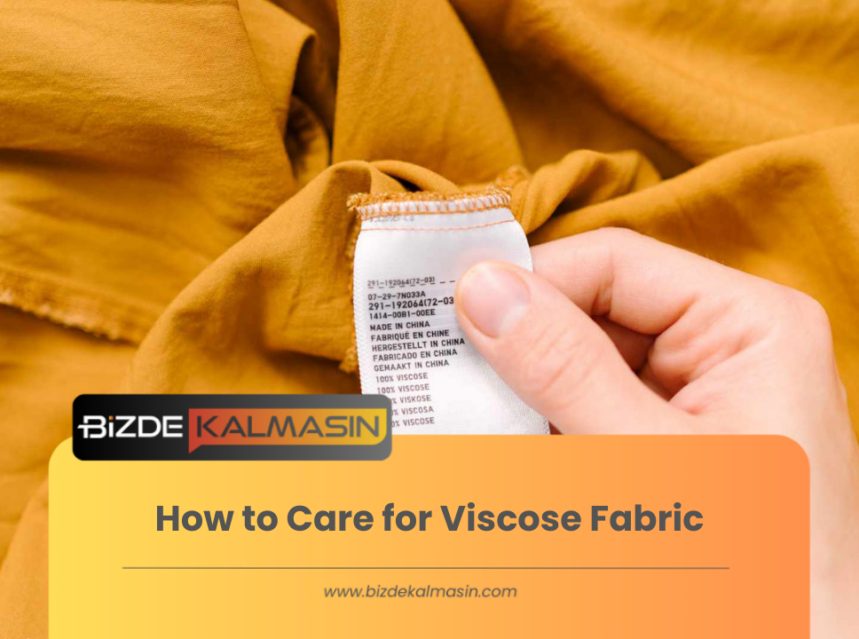How to Care for Viscose Fabric ⏬👇

Viscose, also known as rayon, is a semi-synthetic fabric made from regenerated cellulose fibers. It is popular for its softness, breathability, and ability to imitate silk, cotton, and wool. However, viscose also has some drawbacks, such as its tendency to shrink, wrinkle, and lose shape over time. Therefore, it is important to know how to care for viscose fabric properly to maintain its beauty and durability. Here are some tips on how to wash, dry, iron, and store viscose fabric.

Washing Viscose Fabric
The first step to caring for viscose fabric is to check the care label on the garment or fabric. Some viscose items may be labeled as dry-clean only, which means they should not be washed at home. However, most viscose items can be hand-washed or machine-washed with care. Here are some guidelines for washing viscose fabric:
- Hand-wash viscose in cool water with a gentle detergent. Avoid using hot water as it can cause the fibers to break down. Avoid twisting or wringing viscose fabric because doing so can harm the fibers. Instead, gently squeeze any extra water out.
- Machine-wash viscose with like colors on a delicate cycle with cold water and a mild detergent. Do not use bleach or fabric softener as they can damage the fibers. Use a mesh laundry bag to protect the fabric from snagging or stretching.
- Rinse viscose thoroughly to remove any soap residue. Soap residue can make the fabric stiff and dull. Use cold water and avoid wringing or twisting the fabric.
Drying Viscose Fabric
The next step to caring for viscose fabric is to dry it properly. Viscose fabric should never be tumble-dried as the heat and friction can cause shrinkage, pilling, and loss of shape. Here are some guidelines for drying viscose fabric:

- Line-dry viscose by hanging it on a non-metal wire or a padded hanger. Metal wires can leave rust stains on the fabric. Padded hangers can prevent the fabric from stretching or sagging. Avoid direct sunlight as it can fade the color of the fabric.
- Alternatively, lay viscose flat on a clean, dry towel and roll it up to absorb the excess moisture. Then, unroll the towel and lay the fabric flat on another dry towel or a drying rack. Do not fold or stack the fabric as it can cause creases or wrinkles.
- Reshape viscose fabric by gently pulling and smoothing it to its original form as it dries. Do not leave it crumpled or twisted as it can cause permanent wrinkles or distortions.
Ironing Viscose Fabric
The final step to caring for viscose fabric is to iron it if needed. Viscose fabric is prone to wrinkling, especially after washing and drying. However, ironing viscose fabric requires some caution as the heat and pressure can damage the fibers. Here are some guidelines for ironing viscose fabric:
- Iron viscose fabric while it is still slightly damp or use a steam iron. This can help relax the fibers and remove the wrinkles more easily. Avoid ironing viscose fabric when it is completely dry as it can scorch or burn the fabric.
- Set the iron to a low or medium heat setting and use a pressing cloth to protect the fabric from direct heat. A pressing cloth can be a thin cotton cloth or a piece of white paper. Do not use a colored cloth or paper as it can transfer dye to the fabric.
- Iron viscose fabric on the wrong side or the inside of the garment or fabric. This can prevent the fabric from getting shiny or glossy on the right side or the outside. Use gentle strokes and avoid pressing too hard or for too long on one spot.
Storing Viscose Fabric
The last step to caring for viscose fabric is to store it properly. Viscose fabric should be stored in a cool, dry, and dark place away from direct sunlight, heat, and moisture. Sunlight, heat, and moisture can cause the fabric to fade, shrink, or mold. Here are some guidelines for storing viscose fabric:
- Fold viscose fabric loosely and place it in a breathable container or bag. Do not use plastic bags or containers as they can trap moisture and cause mildew. Do not fold viscose fabric too tightly or stack it too high as it can cause creases or wrinkles.
- Hang viscose fabric on padded hangers or non-metal wires. This can prevent the fabric from stretching or sagging. Do not use metal hangers or wires as they can rust and stain the fabric. Do not hang viscose fabric too close to other garments or fabrics as it can cause color bleeding or rubbing.
- Use cedar balls or sachets to repel moths and other insects that can damage the fabric. Do not use mothballs or chemical repellents as they can leave a bad odor or residue on the fabric.
Viscose vs. Other Fabrics ⏬👇
Viscose fabric has some similarities and differences with other fabrics, such as polyester, rayon, and bamboo. Here are some comparisons of viscose with these fabrics:
Viscose vs. Polyester
Polyester is a synthetic fabric made from petroleum-derived polymers. It is durable, wrinkle-resistant, and easy to care for. However, it is also less breathable, more prone to static, and less eco-friendly than viscose. Here are some pros and cons of viscose and polyester:
- Viscose is more breathable, absorbent, and comfortable than polyester. It can keep you cool in hot weather and warm in cold weather. Polyester can trap heat and moisture, making you feel sweaty and uncomfortable.
- Viscose is more eco-friendly than polyester. It is made from renewable and biodegradable sources, such as wood pulp or bamboo. Polyester is made from non-renewable and non-biodegradable sources, such as petroleum. It also releases microplastics into the environment when washed.
- Polyester is more durable and wrinkle-resistant than viscose. It can withstand wear and tear, washing and drying, and ironing better than viscose. Viscose can shrink, wrinkle, and lose shape over time. It requires more gentle and careful handling than polyester.
Viscose vs. Rayon
Rayon is a generic term for regenerated cellulose fibers, such as viscose, modal, and lyocell. Viscose is a type of rayon that is made from wood pulp or cotton linter. It is the oldest and most common type of rayon. Here are some similarities and differences between viscose and rayon:
- Viscose and rayon have similar properties, such as softness, breathability, and absorbency. They can both imitate natural fabrics, such as silk, cotton, and wool. They can both be dyed with vibrant colors and blended with other fibers.
- Viscose and rayon have similar drawbacks, such as shrinkage, wrinkling, and loss of shape. They both require gentle washing and drying and low-heat ironing. They both weaken when wet and can be damaged by heat and friction.
- Viscose and rayon have different manufacturing processes, which can affect their environmental impact. Viscose uses more chemicals and water than other types of rayon, such as modal and lyocell. It also produces more waste and pollution than other types of rayon. However, some viscose producers use closed-loop systems that recycle water and chemicals and reduce emissions.
Viscose vs. Bamboo ⏬👇
Bamboo is a natural fiber that comes from the bamboo plant. It is fast-growing, renewable, and biodegradable. It is also antibacterial, hypoallergenic, and odor-resistant. However, bamboo fiber is not the same as bamboo fabric. Bamboo fabric can be made from bamboo fiber or bamboo viscose. Here are some distinctions between viscose and bamboo:
- Bamboo fiber is a mechanical process that extracts the fiber from the bamboo plant without using chemicals. It is similar to linen or hemp fiber. It is coarse, stiff, and expensive. It is rarely used for clothing or bedding.
- Bamboo viscose is a chemical process that dissolves the bamboo pulp into a viscous liquid and then spins it into fibers. It is similar to viscose or rayon fiber. It is soft, smooth, and affordable. It is widely used for clothing and bedding.
- Bamboo viscose has the same advantages and disadvantages as viscose or rayon. It is breathable, absorbent, and comfortable. It is also prone to shrinkage, wrinkling, and loss of shape. It requires gentle washing and drying and low-heat ironing. It weakens when wet and can be damaged by heat and friction.
- How to Care for Viscose Fabric ⏬👇
- How to Find Sony Speaker Zma Files ⏬👇
- Chainsaw Man Manga Free⏬ Man Manga Free Read
🚀 We prepared it with love, psymagicshrooms team 🎮 | psymagicshrooms.com



